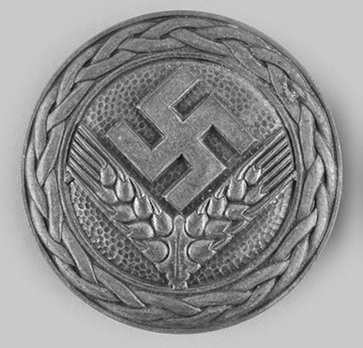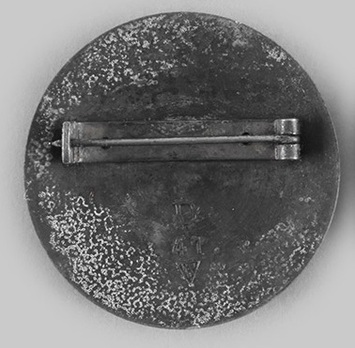RADwJ 1939 Maidenhauptführerin Rank Brooch
CATEGORY: Version
SKU: 80.GOR.03.02.09.03.004.000
Estimated market value:


Estimated market value:
Maidenhauptführerin rank badge, constructed of silvered zink, horizontal pinback, the obverse consisting of a circular knotted wreath, with a central raised mobile swastika within dual wheat stalks, on a pebbled field, the reverse marked “D 41” with a RADwJ insignia, measuring 44 mm in diameter, in near extremely fine condition.
The RAD (Reichsarbeitsdienst = Reich Labour Service) was officially established on June 26, 1935 as the sole, and compulsory, labour service of Germany. Its purposes were to help the economy, curb unemployment, and indoctrinate its members with the NSDAP ideology, as well as play its part in militarising the German population.
The FAD (Freiwilliger Arbeitsdienst = Voluntary Labour Service) was the precursor of the RAD in the early 1930s. Official uniform regulations were first introduced on October 1, 1933, with modifications made in July 1934. It is also known as NSAD (Nationalsozialistischer Arbeitsdienst = National Socialist Labour Service).
The earliest uniforms were a not entirely successful attempt at standardisation. They gave way to a second wave of FAD uniforms that, when the RAD was established, experienced no significant changes.
The Reichsarbeitsdienst der weiblichen Jugend (RADwJ, Reich Labour Service of Female Youths) was the female branch of the RAD. It was smaller than the male branch. In accordance with the place of a woman within the nationalsocialist ideology, the tasks the young women were assigned were chosen to prepare them for a domestic life of caring and nurturing. They included, for example, light farm work, taking care of the young, the old, and the sick, and organising entertaining events. While outwardly organised in a similar manner as the male branch, including the wear of uniforms, the RADwJ was much less militarised.
A new rank system and new brooches were introduced on October 11, 1939. The design of the centre of the brooch is unchanged, compared with the 2nd pattern of 1937, but the rim no longer features an inscription. Instead, the different rim design patterns were used to denote rank.
Maidenhauptführerinnen wore a brooch with a silver-coloured ornamented rim with a braided design, as well as silver-coloured collar piping.

Comments
Sign in to comment and reply.


Scroll Top